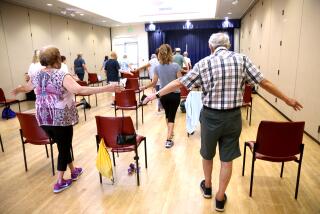HOME IMPROVEMENT : How to Change Things to Make Aging a Little Easier
- Share via
A recent survey found that 84% of Americans 55 and older want to retire in the home they now live in. For many, however, the desire conflicts with the reality of diminished vision, hearing and physical dexterity.
The aging process starts early--noticeable changes begin at around 40--so learning to compensate with simple, often inexpensive changes in the home can be invaluable.
The most common change is loss of visual perception, experienced by 95% of older adults, according to ITT Hartford. The insurance company has developed a booklet and video based on a traveling exhibition of 120 design ideas for safer homes. Among the tips:
To compensate for loss of visual sharpness, add lighting, especially where activities such as reading and writing, cooking and taking medication are going on. Stairways and bathrooms are where most home accidents occur, so good lighting there is essential.
As the ability to focus on nearby objects diminishes, clocks, thermometers and other appliances with small print should be replaced with models that have larger numerals and letters. Keep a magnifying glass near the telephone book and dictionary.
Glare from lights bothers people more as they age. To control it, use translucent shades on all lamps, cover windows with light-filtering blinds or shades and choose matte finishes rather than shiny materials for wall coverings and countertops.
To make it easier to distinguish barriers such as furniture and steps, create contrasts. Put a light color from the red and orange family against a darker shade of blue or green. In the Hartford display, light-colored wall coverings contrasted with dark flooring, and switch plates, cabinets and furnishings were chosen to contrast with the background.
Diminished hearing can make doorbells, telephones and alarms inaudible. Compensate with carpeting, upholstery and fabric window treatments that reduce echo and absorb noise. Place chairs closer together to make conversation easier.
Since older people often don’t detect odors as well as they used to, use smoke detectors.
To compensate for decreased ability to feel heat, cold and pain, put governors on faucets that automatically mix cold and hot water to a comfortable temperature. The device costs about $15, according to ITT Hartford. Cooktops and stoves should have controls at the front and staggered burners so you don’t have to reach over hot pans and burners.
To overcome diminished mobility, remove scatter rugs or glue them down, substitute levers and C-shaped handles for other styles, and rearrange furniture to eliminate booby traps such as low coffee tables and obstructions in front of windows. Rearrange contents of cabinets so frequently used items are easy to reach.
Additional suggestions from Kenneth Ricci, a New York architect who developed a checklist for removing home hazards, include:
Remove sills and thresholds on interior doorways to reduce the chance of tripping.
Make washer and dryer and circuit breaker more accessible by moving them up from the basement.
Place handrails strong enough to bear full weight on both sides of the stairs. Put grab bars in the bathtub and near the toilet.
Replace the refrigerator with a side-by-side refrigerator-freezer.
Replace pots and pans that wobble or tip easily. Get a whistling tea kettle.
If you don’t have the money for major renovations, check with a city or state department of aging for low-interest or deferred-payment loans. Some county, state and local governments offer them, according to the American Assn. of Retired Persons.
A reverse mortgage is one route to renovating and affording to stay in your home, the AARP says. Such mortgages provide a homeowner with a monthly payment. The loan is repaid when the house is sold after the owner’s death. Home equity loans also can be a source of capital for needed improvements.
AARP booklets that explore options include: “The Doable Renewable Home,” (D12470); “Your Home, Your Choice,” (D12143); and “Housing Options for Older Americans,” (D12063). Write to AARP Fulfillment, EE0094. 1909 K St., N.W., Washington, D.C., 20049. Include the stock number with your request.
“For the Rest of Your Life” is a 28-minute video of ideas and products that can compensate for impairments of aging. It can be borrowed by writing to The Hartford House, Modern Talking Pictures, 5000 Park St. North, St. Petersburg, Fla., 33709. For a booklet with the same information, send a business-size envelope with 65 cents postage and your address to The Hartford House, P.O. Box 4460, Hartford, Conn., 06146.
More to Read
Sign up for Essential California
The most important California stories and recommendations in your inbox every morning.
You may occasionally receive promotional content from the Los Angeles Times.













